Every person has their personal conception on the subject of Water Heater Maintenance Tips You Can't Afford to Forget.

Hot water is essential for day-to-day convenience, whether it's for a refreshing shower or cleaning meals. To ensure your warm water system runs effectively and lasts longer, normal maintenance is key. This post offers practical ideas and insights on just how to preserve your home's warm water system to prevent disturbances and expensive repairs.
Intro
Preserving your home's warm water system may seem complicated, however with a few straightforward steps, you can guarantee it operates efficiently for many years ahead. This guide covers everything from understanding your warm water system to DIY upkeep suggestions and recognizing when to hire specialist assistance.
Relevance of Preserving Your Hot Water System
Normal maintenance not just extends the life expectancy of your hot water system however additionally ensures it runs efficiently. Ignoring upkeep can result in lowered efficiency, greater power bills, and also premature failure of the system.
Indicators Your Hot Water System Requirements Upkeep
Knowing when your warm water system requires attention can stop major problems. Keep an eye out for signs such as inconsistent water temperature level, strange noises from the heating system, or rusty water.
Flushing the Hot Water Heater
Flushing your hot water heater removes sediment buildup, enhancing effectiveness and extending its life.
Monitoring and Changing Anode Rods
Anode poles protect against corrosion inside the tank. Examining and replacing them when worn out is essential.
Complex Problems Needing Expert Assistance
Instances consist of significant leakages, electric issues, or if your hot water heater is constantly underperforming.
Routine Professional Maintenance Conveniences
Specialist upkeep can consist of complete examinations, tune-ups, and making certain compliance with security requirements.
Examining and Readjusting Temperature Settings
Adjusting the temperature setups makes certain optimum efficiency and security.
DIY Tips for Maintenance
You can perform several upkeep jobs on your own to maintain your hot water system in top condition.
Looking for Leakages
Regularly inspect pipes and connections for leaks, as these can bring about water damages and greater costs.
Recognizing Your Warm Water System
Prior to diving right into upkeep jobs, it's valuable to comprehend the fundamental elements of your hot water system. Generally, this includes the water heater itself, pipes, anode poles, and temperature level controls.
Month-to-month Maintenance Tasks
Routine monthly checks can help catch small problems before they escalate.
Examining Pressure Relief Valves
Examining the stress relief valve guarantees it works appropriately and stops excessive stress accumulation.
Insulating Pipelines
Protecting hot water pipelines decreases warmth loss and can save power.
When to Call an Expert
While DIY upkeep is advantageous, some concerns require specialist competence.
Conclusion
Routine upkeep of your home's warm water system is vital for efficiency, long life, and expense savings. By adhering to these ideas and knowing when to look for professional aid, you can make sure a reputable supply of hot water without unanticipated disruptions.
How to Maintain an Instant Hot Water Heater
Before tinkering with your hot water heater, make sure that it’s not powered on. You also have to turn off the main circuit breaker and shut off the main gas line to prevent accidents. Also turn off the water valves connected to your unit to prevent water from flowing into and out of the appliance. 2. When you’re done, you have to detach the purge valves’ caps. These look like the letter “T†and are situated on either side of the water valves. Doing so will release any pressure that has accumulated inside the valves while at the same time avoid hot water from shooting out and burning your skin. 3. When the purge valves’ caps are removed, you have to connect your hosing lines to the valves. Your unit should have come with three hoses but if it didn’t, you can purchase these things from any hardware or home repair shops. You can also get them from retail stores that sell water heating systems. Read the user’s manual and follow it to complete this task properly. When the hosing lines are connected, open the purge port’s valves. 4. You should never use harsh chemical cleaners or solutions when cleaning your unit. Make use of white vinegar instead. It should be undiluted and you’ll probably use about 2 gallons. 5. Now flush your water heater. This task should probably take about 40 minutes. We can’t give you specific directions for this because the procedure is carried out depending on the type, model and brand of your heater. With that being said, refer to the user’s manual. 6. When you’re done draining the unit, you have to turn off the purge port valves again. Remove the hosing lines that you earlier installed on each of the water valves. Put the valve caps (purge port) back in their respective places and be very careful so as not to damage the rubber discs that are found inside these caps. 7. Now that everything’s back in place, check your user’s manual again to find out how to reactivate your water heating system. 8. Once it is working, turn one of your hot water faucets on just to let air pass through the heater’s water supply pipes. Leave the tap on until water flows smoothly out of it. https://www.orrplumbing.com/blog/2014/september/how-to-maintain-an-instant-hot-water-heater/

We were made aware of that editorial about Tips For Maintaining Your Hot Water Heater through a good friend on our other web property. Be sure to pause to distribute this content if you enjoyed reading it. We thank you for your readership.
Click Here